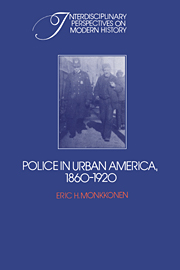Summary
Two periods of urban change
By 1920, the policing of American cities had gone through two periods of innovation, the first from approximately 1850 to 1885, the second in the 1890s. Each period shaped a new model of social control for cities; however, the precise way each model worked and to whose benefit it functioned could neither have been clearly perceived nor precisely intended at the time. Even today the existence and nature of these two innovational periods remain obscured by misfocused arguments over the social causations of criminal behavior, by analyses of social control agencies that assume all important consequences were intended and had simple antecedents, and by confusion over the behavioral outcomes of the progressive reforms of police. An analysis and understanding of criminal justice systems, not accounting for individual propensity to commit criminal offenses, does show how social institutions control and divert this behavior. To assume that social control by its very nature is reprehensible gives no insight into the controlled behavior, the social control institution, nor the society that houses the institution. And to examine police reform outside a precisely defined description of both its structural location in society and its behavioral effects does little to promote our understanding of social institutions. The implicit perspective of these three issues – the “cause” of criminal behavior, the assumption that all social control is oppressive, and the examination of reform without prior understanding of structure – have tended to raise wrong questions and inappropriate methods.
- Type
- Chapter
- Information
- Police in Urban America, 1860–1920 , pp. 148 - 161Publisher: Cambridge University PressPrint publication year: 1981



